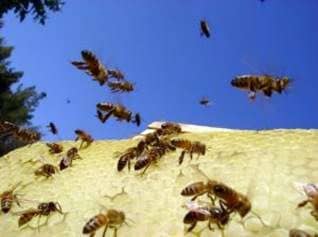Artificial over-flight overflights of bees

The work is carried out in the first half of October, when you can not count on a natural flight of bees. At a temperature of 10-12 њ C, the windless and sunny pavilion warms up to 20-22 њ C. During this period, bees are given 200-250 ml of warm syrup, placing an inverted half-liter jar tied with gauze in 3-4 layers on the central opening of the ceiling. Bees, as a rule, go to an artificial, super-late flight.
After flying over the bees, the remaining brood in the lower shell, if present, is destroyed, and the honeycombs with brood are replaced with honeycombs with 1-1.5 kg of honey. From the upper shells, the outer frames are removed, in which the perg was substituted. Finally, in the lower framework, there should be 0.5-1.5 kg of honey.
In the upper case with frames filled to the bottom bar, there should be 18-20 kg of honey. After flying around and final assembling of the nests, bees are treated with folbek, neorone, acin or other means according to the current instruction.
The temperature in the pavilion is at the same time maintained at least 18-20 њ C, since only at a temperature of more than 14 њ C the efficiency of the folkes (in the absence of brood) is high enough (more than 90%). In addition, with
At low temperatures, the bees form a club, and the processing of bees in the club by folbeke sometimes leads to the death of the uterus. So, if the temperature of the outside air at the end of the treatment is below 15 њ C, then for the ventilation of the hives, not the tapholes, but the internal ventilation openings in the pavilion are opened. One day before the treatment with folbeks, 0.5 l of sugar syrup (1: 1) is given to bee families.
Given the possibility of uterine death in the course of late treatment of families with folbekus, it is advisable to either isolate it before this operation, or to have a reserve uterus in the apiary with a small outlay for
The presence of reserve queens allows to save those families in which the uterus during processing will die. The experience of using me in the indicated period of folbeks VA and neonone (acpina) showed that there were no deaths of the queens. We just have to wait for warm weather.
In the spring, the reserve uterus is used to land in those families where there was a loss of queens during the winter. With their help, the apiary is expanded.
As a result of the complex application of physical, zootechnical and chemical methods of killing mites during all the periods of active life, bees manage to keep the mite number at a safe level during the season and the bees leave practically free of parasites during the winter.
The majority of acaricides are poisonous chemicals, therefore, when processing bees, it is necessary to strictly follow the recommendations for their use, dosage and safety. Treatments must be made in a respirator, providing increased ventilation of the pavilion. You should not be in it at that time without the need.
Artificial over-flight overflights of bees
